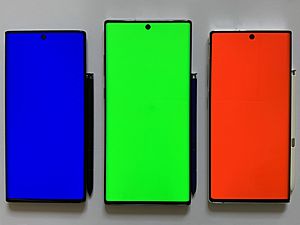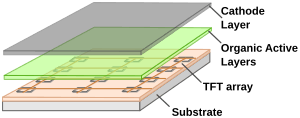AMOLED facts for kids

AMOLED stands for Active Matrix Organic Light Emitting Diode. It's a special type of screen technology used in many electronic devices. You can find AMOLED screens in mobile phones, televisions, and other gadgets that have a display.
An AMOLED screen works by using tiny lights called organic light-emitting diodes (OLEDs). These OLEDs are arranged in a grid, and each one can light up on its own when it gets an electrical signal. This allows the screen to show bright, clear pictures.
Around 2008, AMOLED technology started appearing in phones, music players, and digital cameras. Today, it's becoming even more popular for devices that need to save power, are more affordable, or have very large screens.
Contents
What's Good About AMOLED?
OLEDs are like tiny LEDs, but they are much thinner. Here are some cool things about AMOLED screens:
- No Backlight Needed: Unlike other screens, like LCDs, AMOLED displays don't need a separate light behind them to make the picture visible. Each tiny pixel lights up on its own!
- Saves Energy: Because AMOLED screens don't need a backlight, they use less power. They also create less heat, which means less energy is wasted. This is great for devices like phones, where battery life is super important.
- Good for the Planet: Since they use less energy, AMOLED displays can be considered more eco-friendly.
- Fast and Smooth: AMOLED screens can refresh very quickly, making videos and games look smooth.
- Can Bend and Fold: Some AMOLED screens can even be folded! This allows companies to make phones with screens that wrap around the edges or even fold in half.
What's Not So Good About AMOLED?
Even though AMOLED screens are awesome, they do have a few downsides:
- Screen Burn-in: If the same image stays on the screen for a very long time, especially at full brightness, it can leave a faint, permanent mark. This is called "screen burn-in."
- Water Damage: The materials inside AMOLED screens are organic, which means they can be easily damaged by water. If water gets into the screen, the colors and pixels can get messed up right away. That's why manufacturers have to seal them very carefully.
- Hard to See in Sunlight: AMOLED screens might be a bit harder to see when you're in bright, direct sunlight compared to LCD screens. This is because they don't have a strong backlight. However, companies like Samsung have found ways to make this better by reducing the tiny gaps between the screen layers.
How Companies Talk About AMOLED
Different companies have their own special names for AMOLED screens, even if they get them from the same place!
- Apple calls their AMOLED displays "Super Retina HD."
- Samsung calls theirs "Super AMOLED."
- Companies like Motorola, HTC, and Google also use AMOLED screens, but they might have their own unique names for them too.
Did you know that Samsung makes most of the AMOLED screens in the world? They control about 98% of the market!
What's Next for AMOLED?

Companies are always working to make AMOLED technology even better and fix its problems.
For example, Samsung has shown off the world's first stretchable touchscreen! It's a 9.1-inch screen that can actually stretch and bend. This new screen uses a special technology called LTPS (Low Temperature Polycrystalline Silicon) which helps the pixels move when the screen stretches.
Another company, AU Optronics, is working on putting touch sensors directly into the AMOLED screen during manufacturing. This could make screens even thinner and more responsive.
Images for kids
-
A super close-up view of the AMOLED screen on the Nexus One phone.
-
Dynamic AMOLED displays are used in phones like the Samsung Galaxy Note series, Samsung Galaxy S series, and the Xiaomi Mi 11. This picture shows a Samsung Galaxy Note 10.
See also
 In Spanish: AMOLED para niños
In Spanish: AMOLED para niños



